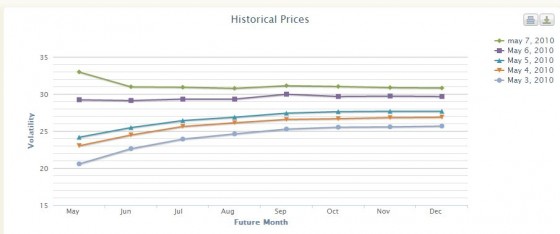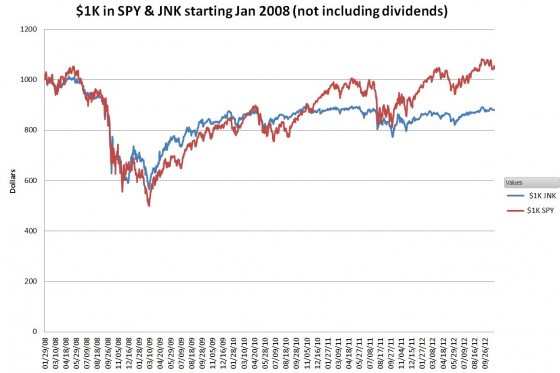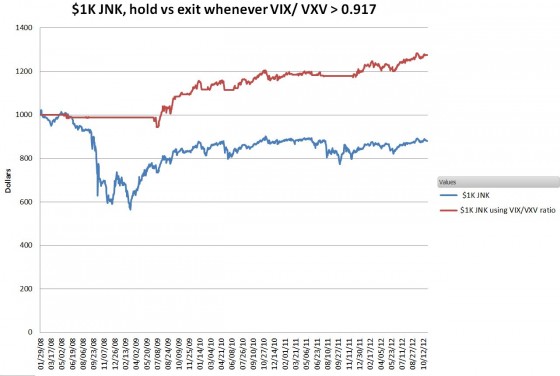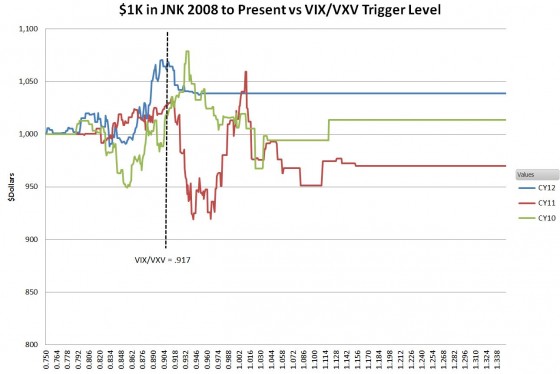The holy grail of investing is a market timing method that gets you out of the market on bad days and gets you in for the good days. There are innumerable methods for doing this, ranging from slogans, “Sell in May and Go Away” to closely guarded multi-factor proprietary algorithms.
The worst methods have no apparent causal relationship between the predictor and the thing being predicted. A non-stock market example is the “Redskins Rule.” Between 1940 and 2008 if the Redskins won the Sunday before the election the party that won the popular vote in the prior election won the presidency—17 out of 18 times. After Obama’s re-election, this rule is now 17 of 19. These non-causal rules are just coincidence, if you look at enough data you will find them everywhere—and they mean nothing.
Most stock market timing methods are based on price action—things like moving averages, technical chart indicators, price/earnings ratios, or pattern recognition. At least they have some sort of connection to the stock market.
Recently I’ve been looking at volatility metrics for predicting market action. The CBOE’s VIX index gets a lot of attention, but using absolute values of the VIX to trigger investments is almost certainly useless. On the other hand, volatility prices over different time frames, often called the term structure, does show significant predictive value.
In a truly bearish market the short term expected volatility, typically cheaper than longer term volatility, climbs higher than the longer term value. This behavior is shared between flavors of VIX (e.g., the one-month VIX & its three-month version VIX3M), VIX futures, and the implied volatility of same strike options of different months. The chart below from VIX Central shows the progression in VIX futures prices from before the May 6, 2012 Flash Crash through the 7th.

A simple metric that captures this behavior divides the short term volatility number by a longer term number. If the ratio is below one the market is relatively calm, if above one the market is especially nervous. I’ve been using the CBOE’s VIX & VIX3M indexes as a convenient way to implement this volatility metric. In 2018 the CBOE changed the symbol for the 3 month calculation of the VIX from VXV to VIX3m. I have changed the text in the post to reflect that but I have not updated the charts.
I’ve been running simulations using the VIX/VIX3M ratio as the entry / exit trigger point for market positions. The chart below shows the price performance of the speculative bond fund JNK, since its inception in 2008 compared with SPY, which tracks the S&P 500.

JNK’s performance would be disappointing if it wasn’t for its high dividend payouts, averaging 10% (!) per year. This next chart shows JNK’s performance if you had closed your JNK position whenever the VIX/VIX3M ratio at market close was greater than 0.917, re-entering when the ratio at close was below that level.

This strategy would have enabled you to avoid the entire 2008/2009 meltdown, plus adding about 3% of extra performance in 2010 through 2012.
Why 0.917? There’s nothing magical about it. It was just the best compromise choice over the last three years. The chart below shows the performance for JNK for all realized VIX/VIX3M levels for 2010, 2011, and 2012.

In my simulations for 2010 through 2012, this threshold worked well for high yield bond funds (JNK, HYG), high dividend funds (SDY), inverse volatility (ZIV,SVXY) and general equity (SPY).
This 0.917 ratio signal worked well until late 2013. For 2014 & 2015 volatility kicked up a bit and the VIX/VIX3M ratio was a loser in determining buy/sell points. After the Brexit vote in 2016, the volatility market went into a dramatic period of low volatility that generated huge profits in the short volatility trade. The 0.917 ratio worked well but basically, anything that approached just being short volatility worked very well—until February 2018 when the sky fell. In the case of the February 5th, 2018 crash the VIX/VIX3M ratio proved to be a good predictor of problems. The ratio was well into the high .9x range and several days before the crash of the 5th.

Dear Vance, thank you very much for this interesting article. I have a question for you when/if you have a moment.
I have incorporated the simple VIX/VIX3M ratio into my automated trading system (trades TVIX 3 min bars intraday only) and I have dumped on a file the values of the ratio for the past 3 years.
I notice that the ratio bottoms at 0.7 and tops at 1.35, which is exactly double the bottom; is this caused by the way the two indexes are calculated?
Thank you in advance!
Hi Sergio, I think this 2X ratio is just a coincidence. The two calculations don’t have any linkage that would cause that. The absolute difference between the maximum and minimum values of the ratio does seem to be pretty stable over time–indicates that the range between maximum backwardation and contango has stayed about the same over time. — Vance
https://www.sixfigureinvesting.com/wp-content/uploads/2019/12/V-ratio-trend.png
Thank you for the reply and chart; for now I haven’t really found an hedge by incorporating the ratio in my day trading strategy. My strategy uses the 21 periods rate of change on 3 minutes bars to predict mean reversion on TVIX (or UVXY or VXX); I couple it with basic trend filters so that it trades short-term mean reversions to the direction of the “trend” (all adjusted by the tendency of the ETF to keep going lower). It’s actually remarkably good at spotting places where volatility (as measured by these instruments) will increase; I went live with the first version of it this past August and it’s been profitable since (now about to swap it out for an improved v2).
It also behaves very well in a variety of market conditions from the backtests.
Do you have any direct experience with trading volatility automatically intraday? I would love to share the details with you privately if you are at all interested if you could give me some general guidance on the topic.. for now it’s been an individual endeavor. Thanks again
Sorry to be digging up the old article, but any advice on how you guys execute this kind of strategies? do you perform them manually checking the prices every night? or automate with conditional trades? or maybe use some algorithmic platform like Quantopian? I’m guessing there are no ETFs/ETNs performing this kind of triggered trades?
There are two mutual funds now that use similar but more sophisticated triggers for investing in Volatility, MRPIX and MRPAX. Only offered via TD Ameritrade, and a bit costly, but up about 21% ytd. I manually check prices daily and with the ratio going over .91 during the day like now, I may day trade-can make 1% a day depending upon whether the S&P is up or down.
Wow, 4.75% load + 2% is indeed quite costly given 3 months of track record 🙂
How similar/correlated are these short volatility strategies going to be with:
* PUTW – ETF that writes cash-covered puts.. isn’t writing puts essentially shorting volatility?
* SPHX – ETF that hedges S&P with some long/short volatility strategy?
Are these simulations done using end of day data? so calculate ratio at end of day and then decide to trade or go to cash? thanks very interesting.
Yes, end of day. Waiting an additional day for confirmation is not a bad choice, often the market action that second day makes it pretty clear which way to go.
Hi, I am new to the volatility trading. do you use the vix and vxv future price to calculate the ratio? Thanks
Hi Riche,
The CBOE publishes VIX and VXV values every 15 seconds while the market is open. On Yahoo their symbols are ^VIX and ^VXV. See this post for links to historical data, etc. VIXcentral.com shows the VIX/VXV ratio if you let your mouse hover over the green VIX line.
The VIX and VXV are calculated from the prices of SPX options. VIX futures normally behave relatively independently from the VIX except at expiration.
Best Regards, Vance
Thanks for sharing your work. I’m a big fan of trading the volatility ETF / ETNs and always looking for better tools.
I was charting ZIV and XIV using the VIX/VXV ratio with a .91 trigger and noticed the ratio triggers nearly identically to the VIX crossing 15.29 and VXV crossing 16.34.
The VIX/VXV ratio was .92 yesterday (1/23/14). Last night, I couldn’t sleep and placed market-on-open sell orders for most of my positions. I am glad I did. Today, the VIX/VXV ratio ended at 1.04 and VIX jumped 32%. I learn a lot from your volatility articles. Thank you!
I am just curious. What would you invest in now or in the near future?
Hi Ping, Glad it worked out for you. The ratio threshold usually doesn’t work as well as it did yesterday, but I think it is better than just the absolute level of the VIX as an indicator of market nervousness.
Regarding investments, I’m guessing the S&P will have a good year, maybe up 12%. Macro economic stuff looks solid and I don’t see any worrisome bubbles yet (e.g, a la tech bubble, or housing bubble). I expect long term interest rates to increase so I’m staying away from longer duration bonds. I still plan to be short volatility (e.g., with ZIV) quite a bit, but I do expect the year to be more volatile than 2012/2013 so I’ll be careful. I’m currently investing some in VelocityShares’ SPXH using 5% OTM puts as an additional hedge. It offers full exposure to the S&P with some protection on the downside.
— Vance
Do you know what ratio would have worked in 2011?
Hi Ed, If you look at the 4th chart you will see the results for 2011. It looks like anything higher than .92 was iffy. There was a peak around a ratio of 1.0, but I would avoid that area because the market is pretty nervous at that point.
Best Regards,
Vance
Thanks Vance: In chart three it sort of looks like the ratio did tend to work in 2011. Without having the ratios in chart 3, I have difficulty in comparing the charts.
I am a little confused regarding the last chart. Is it saying that in 2011, if you sold JNK every time the VIX/VXV level got to say, 0.95 (or anywhere between 0.92-0.98 for that matter), that you would have actually lost money, not gained?
If I am reading the chart correctly it looks like there is a large amount of variation in how performance changes based on both the ratio you sell at and the calendar year. 2011 just looks so much different than the others it is hard for me to see a real trend that says a higher ratio is more bearish.
Hi, Yes in 2011 ratios in that range caused losses–because they didn’t get you out before the drops, and kept you out during the rebounds. This chart shows .95 vs just holding JNK. The green line is the number of shares held. https://www.sixfigureinvesting.com/wp-content/uploads/2012/11/JNK.95.jpg I didn’t include 2009 for clarity, but it shows a similar drop off in performance in the .95 to .975 range.
— Vance
Vance,
Many people quote and track put/call ratios as timing signals. They are just another heuristic to measure the amount of hedging and fear in the S&P options.
Have you tried to see if VIX/VXV is superior to, or can be confirmed by put/call ratios?
I have been using the VIX/VXV ratio daily for over a year. When you plot the ratio over years of data you can see clear waves of complacency and fear. It works as an oscilator too, showing us good reversals at the extremes. This is a useful indicator for a long term investor that wants to make minimal trades.
The trigger value 0.917 is curve fitting but even if an investor used pretty much any value between 0.9 and 1.0, this would help them avoid the nastiest of bear market corrections.
Hi Marc, I’ve never been a put/call ratio fan, at least if they are just tracking volume/open interest because you and I know that calls can be used for bearish strategies as well as bullish. So, no I haven’t compared. I suspect a version of the ratio based on VIX futures would be better. but it would have to be adjusted for constant maturity, which would require some daily work.
I agree that anything between .9 and 1 is a decent threshold.
— Vance